
Natural history museum educates visitors
WASHINGTON, D.C. — Dressed in their trendy tops, skinny jeans and slip-on shoes, 19-year-old Lauren Matthews and 20-year-old Cattie Sweeney looked like girls who should be looking for accessories at the mall.
Instead, the George Washington University students weaved in and out of the crowd at the National Museum of Natural History trying to complete an extra-credit assignment for a geology course.
“I think that this place is really cool,” Matthews, a geography and international affairs major said. “There’s a lot of interesting stuff. I really like the main rotunda with all of the different animals.”
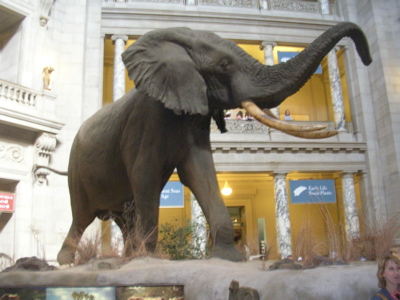 |
A giant African elephant is located on the first floor of the museum (Photo by Marcos Colón). |
Located on NW 10th Street and Constitution Avenue in Washington, D.C., the National Museum of Natural History serves as an immense storage room of knowledge for the thousands of students who visit each day.
“One thing we do that many other museums don’t is take an educational stand-point,” Museum Program Specialist for Guest Services Karen Fitzgerald said. “When students visit us, they get a really great educational experience.”
With more than 20 colleges and universities located around the city area, students who wish to obtain information that ranges from insects to evolution frequently visit the museum.
Dawn Mason, a George Washington student and intern in the Museum Guest Services office this semester, noticed that the number of college students that visit the museum is greater than one would expect.
“We have a lot of college students that come in,” she said. “They actually come in during spring break.”
The George Washington University students, persistent with their assignment, kept looking for different minerals and gems that their worksheet addressed. On their way around the exhibit, they passed through one of the highlights that the museum is known for.
“My favorite exhibit here would have to be the diamonds,” criminal justice and psychology major Sweeney said, referring to the Hope Diamond as her favorite. “I think it’s smaller than you think it would be. There are always so many people around it.”
|
Lions in The Kenneth E. Behring Family Hall of Mammals attack an African buffalo (Photo by Marcos Colón). |
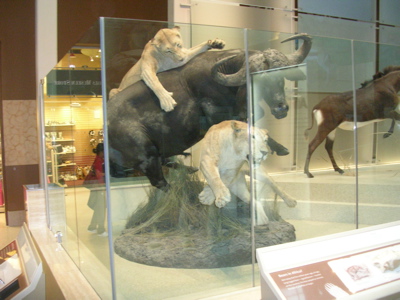 |
Located in the Harry Winston Gallery in a large revolving glass case, the Hope Diamond is one the most significant displays in the museum. It is constantly surrounded by dozens of picture-taking visitors who gawk in amazement at its beauty and blinding shine as the whispers of their oohs and aahs are heard.
“The Hope Diamond is the most visited exhibit in the museum,” Fitzgerald said. “If we had six million visitors last year, probably four million saw the Hope Diamond.”
The Hope Diamond is just one of the many exhibits that draw in the more than six million visitors a year. Other exhibits include African cultures, Ancient seas and the very popular Kenneth E. Behring Family Hall of Mammals. Every exhibit in the museum is organized from early to more recent periods in time.
“Our new mammal hall opened in 2003 and I think it’s fantastic,” Fitzgerald said. “We have a panorama of what it would be like to be in Africa amongst the animals. Everything there has been re-taxidermied and shampooed and made new. The animals there cover all areas from around the world.”
In The Kenneth E. Behring Family Hall of Mammals, animals range from tigers to rhinoceros. Here visitors can witness the immense height of a giraffe or the intimidating lower jaw of a hippopotamus.
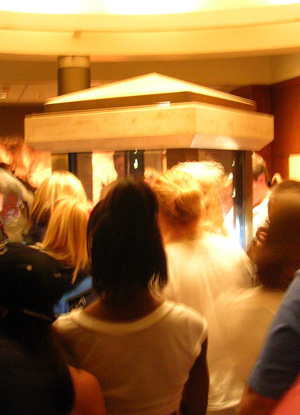 |
As one of the most visited exhibits in the museum, visitors constantly surround the Hope Diamond (Photo by Marcos Colón). |
Each of the animals is located behind glass or mounted high, away from ones reach. Some are positioned in a natural scenario, most notably the two lions attacking an African buffalo.
As children pass this scene, some are amazed at the attack while others are sad at the sight of the buffalo’s doom.
Traveling during their spring break with a group of college friends from the Massachusetts Institute of Technology, 20-year-old Elizabeth Reid’s last stop before heading back to Boston was Washington, D.C. All that the museum had to offer amazed her and her companions.
“So far I’ve liked what I’ve seen here,” the computer science major said. “I find evolution and the study of it interesting and I like the way they presented it here. I thought the way they handled controversial topics was very well done. Things like the extinction of the dinosaurs and evolution.”
Joseph O’Connor, one of Reid’s college colleagues, also enjoyed the museum, but one characteristic astonished him.
“I was pleasantly surprised that it was free,” he said. “Anyone can pretty much come in. That’s why a lot of school groups are here.”
Mason believes that one of the greatest perks that a visitor receives from the museum is its free access.
“I think what’s great about the Smithsonian is that, except for the Cooper-Hewitt, they are free to the public,” she said. “The only thing they would have to pay for is if they were to go to an IMAX film, any retail shops or buy food.”
| The dinosaur display is a favorite to young visitors in the museum (Photo by Marcos Colón). | 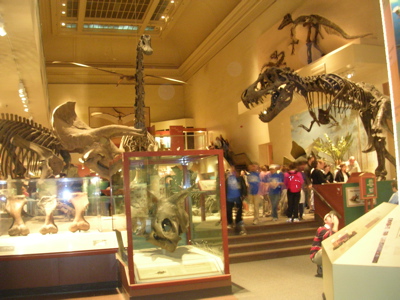 |
One unique characteristic of the National History Museum is its IMAX theatre where a variety of films are shown each day that range from Hurricane on the Bayou to Lions 3D. The auditorium seats 560 visitors and other than screening films performances and lectures are held there as well.
“Very few museums have an IMAX theatre,” Fitzgerald said. “They can be found primarily in major city museums. I think that we show a nice variety of films here.”
Significant changes are currently being made to the museum. The bug zoo is currently being renovated and soon there will be the addition of Ocean Hall where there will be an endless array of sea life including two giant squids.
“Our new ocean hall will be the largest hall in the National Mall,” Fitzgerald said. “We will have all sorts of ocean life.”
The special O. Orkin Insect Zoo exhibit, located on the second floor, is currently being renovated and upon completion will have one of the only indoor butterfly habitats in the nation. Fitzgerald said that the live butterfly hall will have a charge to get in, but the exhibit as well as the insect hall will be free.
“We’re going to start building what we’re calling Butterflies and Plants: Partners in Evolution,” Fitzgerald said. “It will show how insects and plants work together and how they’ve co-evolved through history.”
Another significant aspect of the museum is that it’s located in the National Mall where many other museums are. There is also its location in the city and its proximity to other prominent places such as the monuments and the various shops and restaurants in the area.
“I like that all the museums are together,” Matthews said. “It makes it easier for you and its really easy for us because we live like 10 blocks from here.”
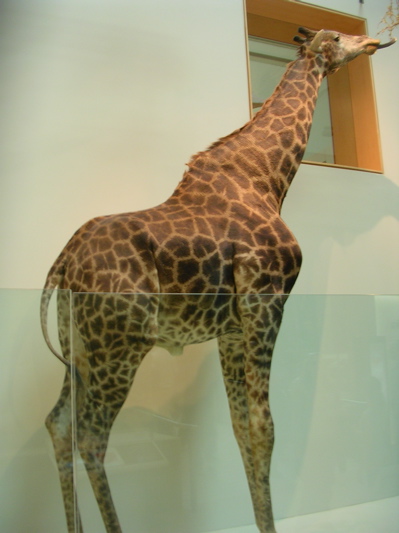 |
In The Kenneth E. Behring Family Hall of Mammals visitors can witness the actual size of a giraffe (Photo by Marcos Colón). |
As visitors leave the museum, other places they are able to visit are the Washington Monument, American History Museum, Postal Museum and Air and Space Museum that are all within walking distance of the National Museum of National History.
For students visiting Washington, D.C., the Natural History Museum should be listed on their agenda of things to do.
“It’s a very thorough museum,” O’Connor said. “They have a lot of information. I would definitely recommend other students to come. Plus, it’s free!”
If You Go
- Location: Located at 10th Street and Constitution Avenue, NW, Washington, D.C. Accessible entrance is on the Constitution Avenue side at 10th Street.
- Hours: Daily, 10 a.m. to 5:30 p.m. Closed Dec. 25. The hours are extended in spring and summer and are determined yearly.
- To avoid crowds try to plan a visit during the winter months. Spring and summer months are extremely crowded and busy.
- Parking: There is no public parking facility at the Smithsonian on the National Mall. Some commercial parking lots are available several blocks from the museum. There are a limited number of parking spaces available for visitors with disabilities.
- Admission: There is no admission fee to enter. Programs are free of charge unless otherwise noted.
- Metro Stations: Closest stops on the Blue and Orange Lines are Smithsonian and Federal Triangle. The nearest Yellow and Green Line stop is Archives/Navy Memorial.
- Food: The Atrium Café is located on the ground floor and Fossil Café is located on the first floor. Both are open 10 a.m. to 5 p.m. daily. Group meals at the Atrium Café are offered at a discount may be purchased before your visit: contact 866-868-7774.
- IMAX Theatre: Movies are scheduled throughout the day and tickets are $8.50. Tickets are available online at http://www.si.edu/imax or by calling 877-932-4629
- Museum Shops: The main gift and bookstores are located on the ground floor. The Mammals Museum stores is on the 1st floor. The Gems and Minerals Store is located on the 2nd floor off the Rotunda Gallery.
- For more information call Smithsonian Information at 202-633-1000 or visit http://www.mnh.si.edu.

Comments are Closed